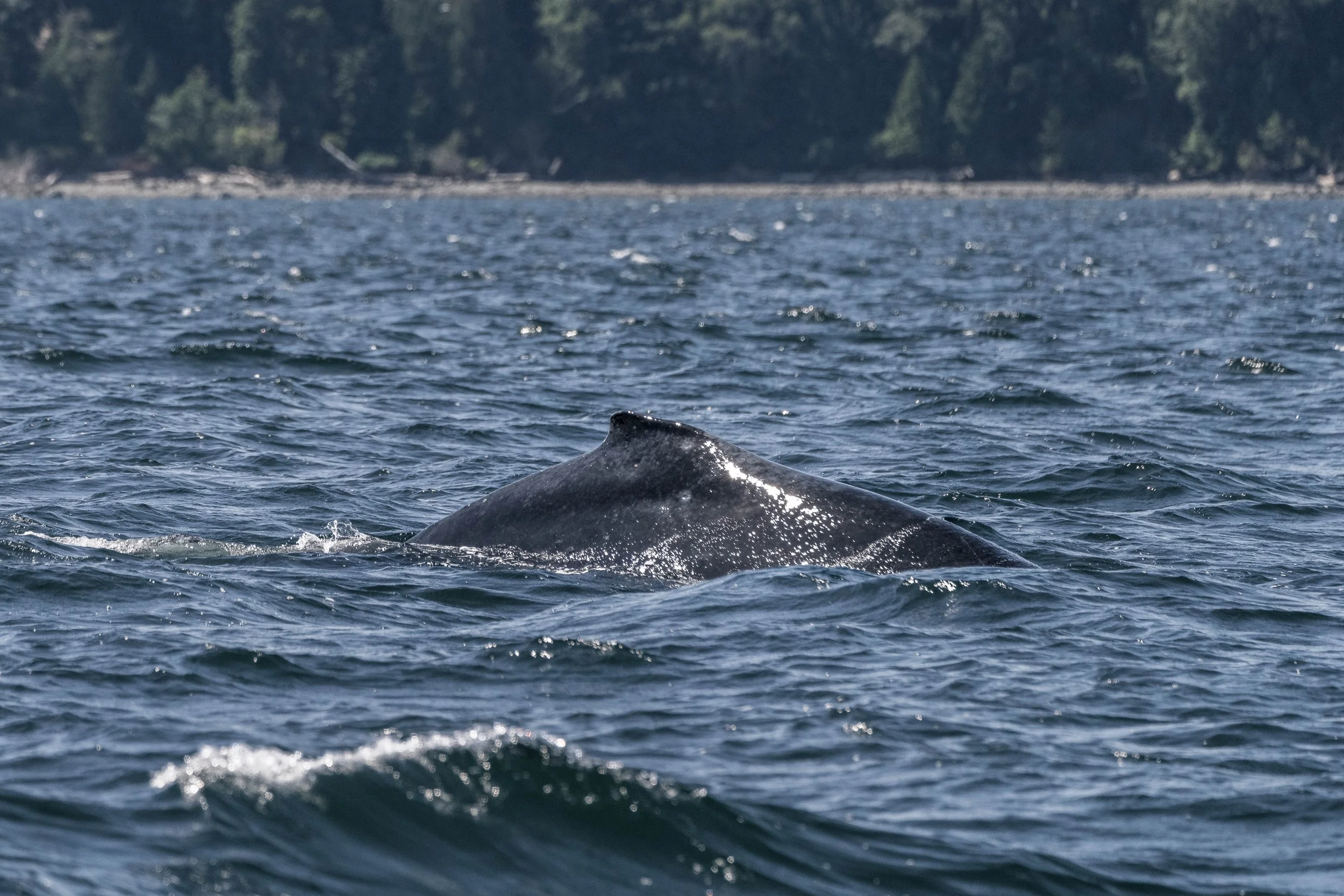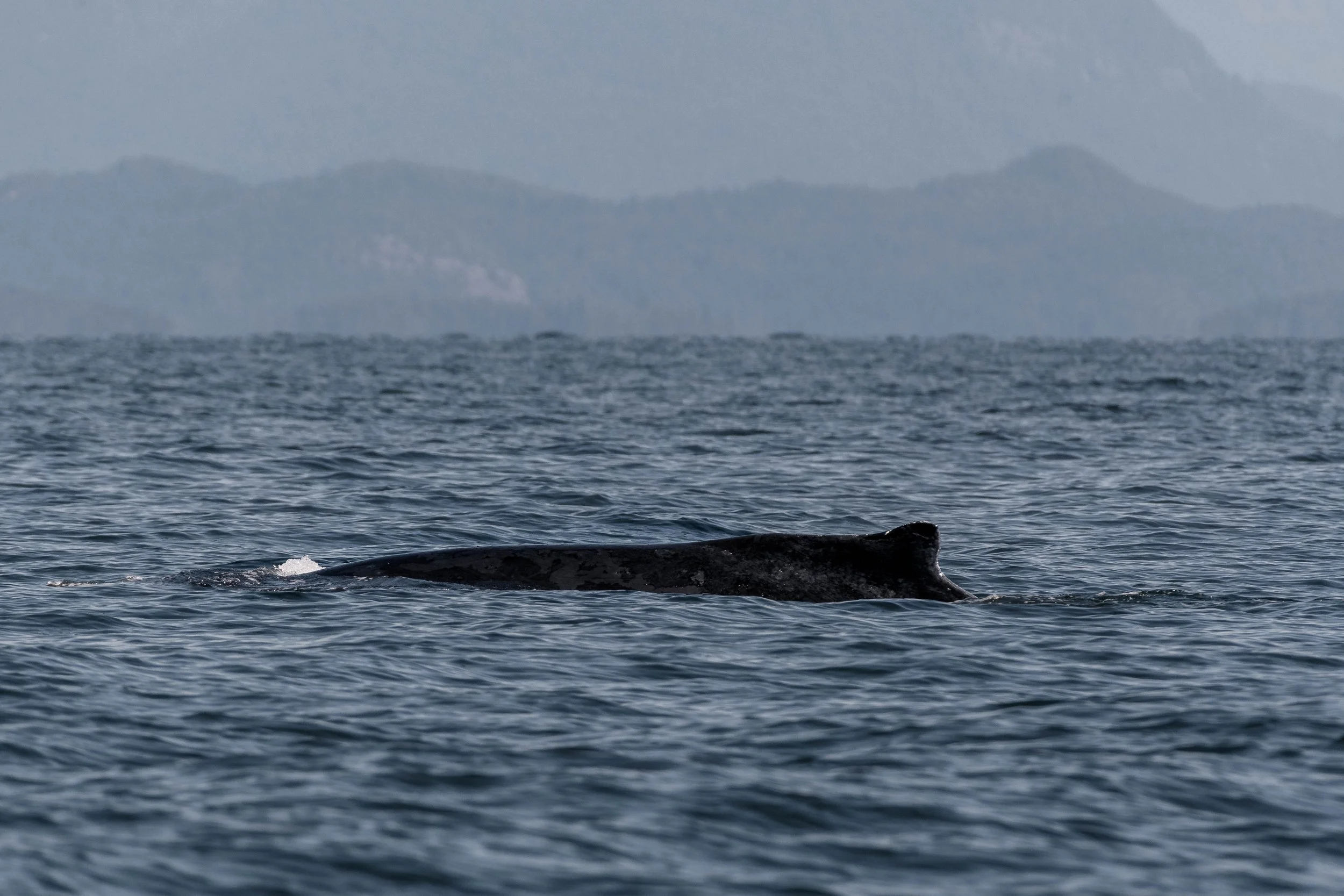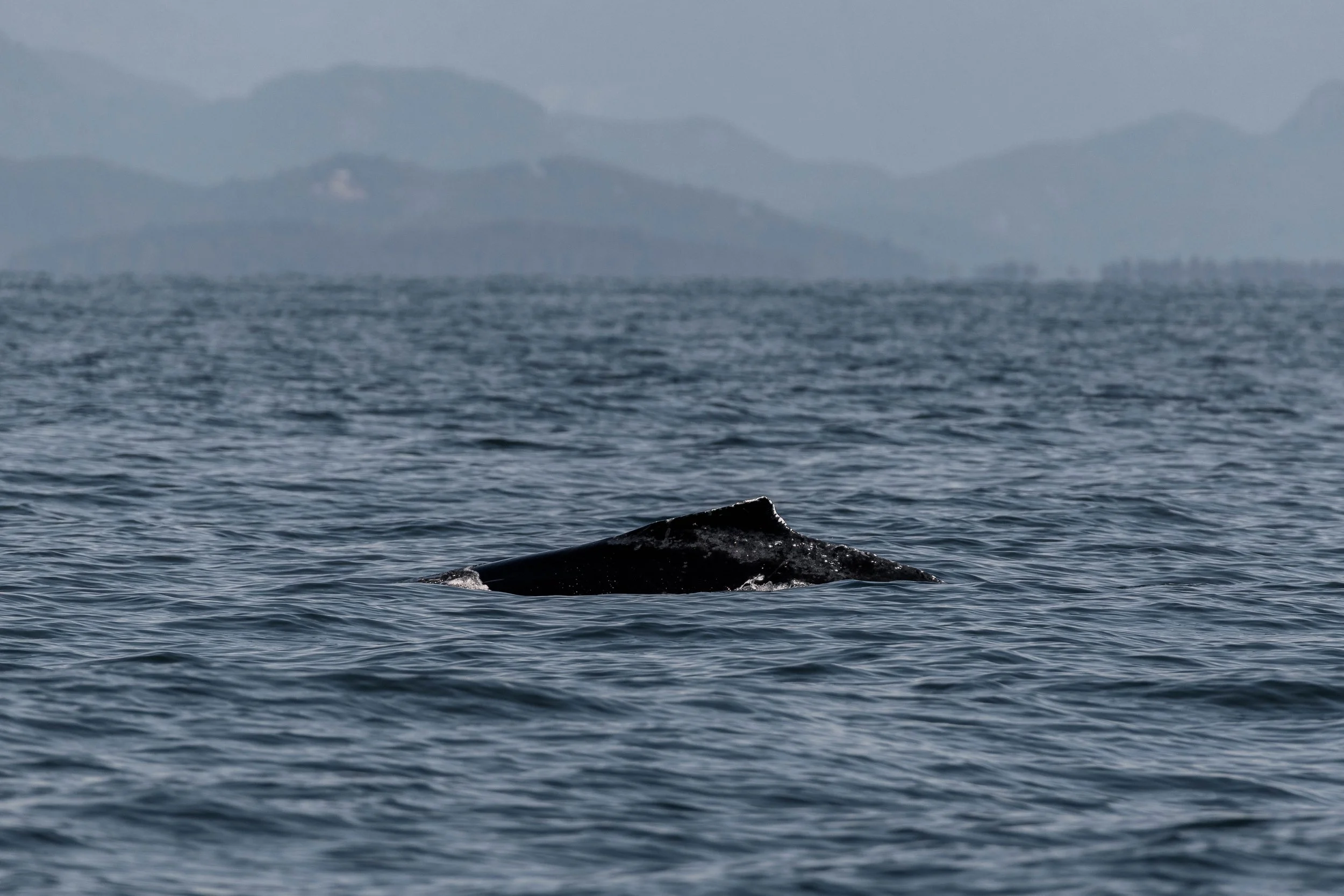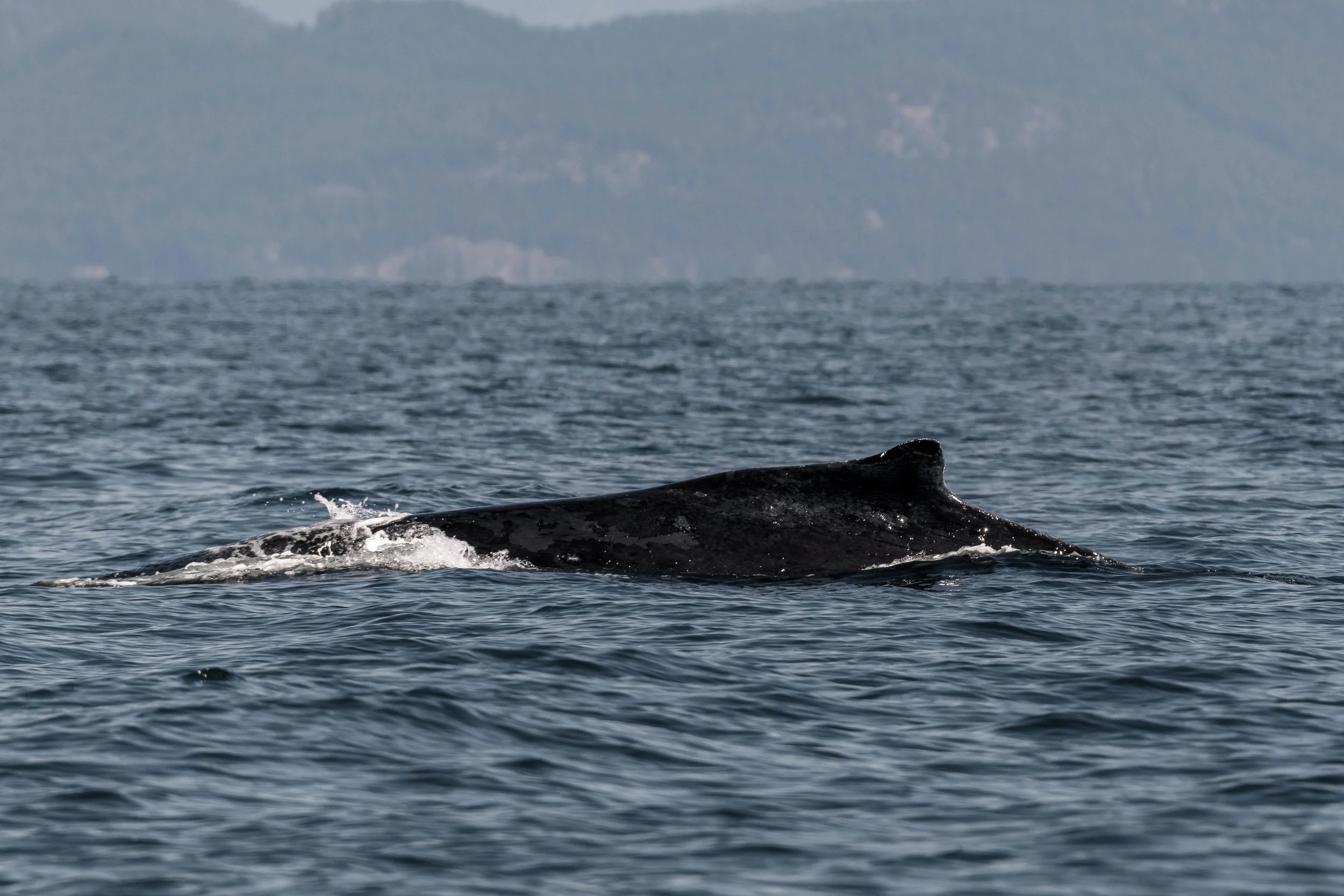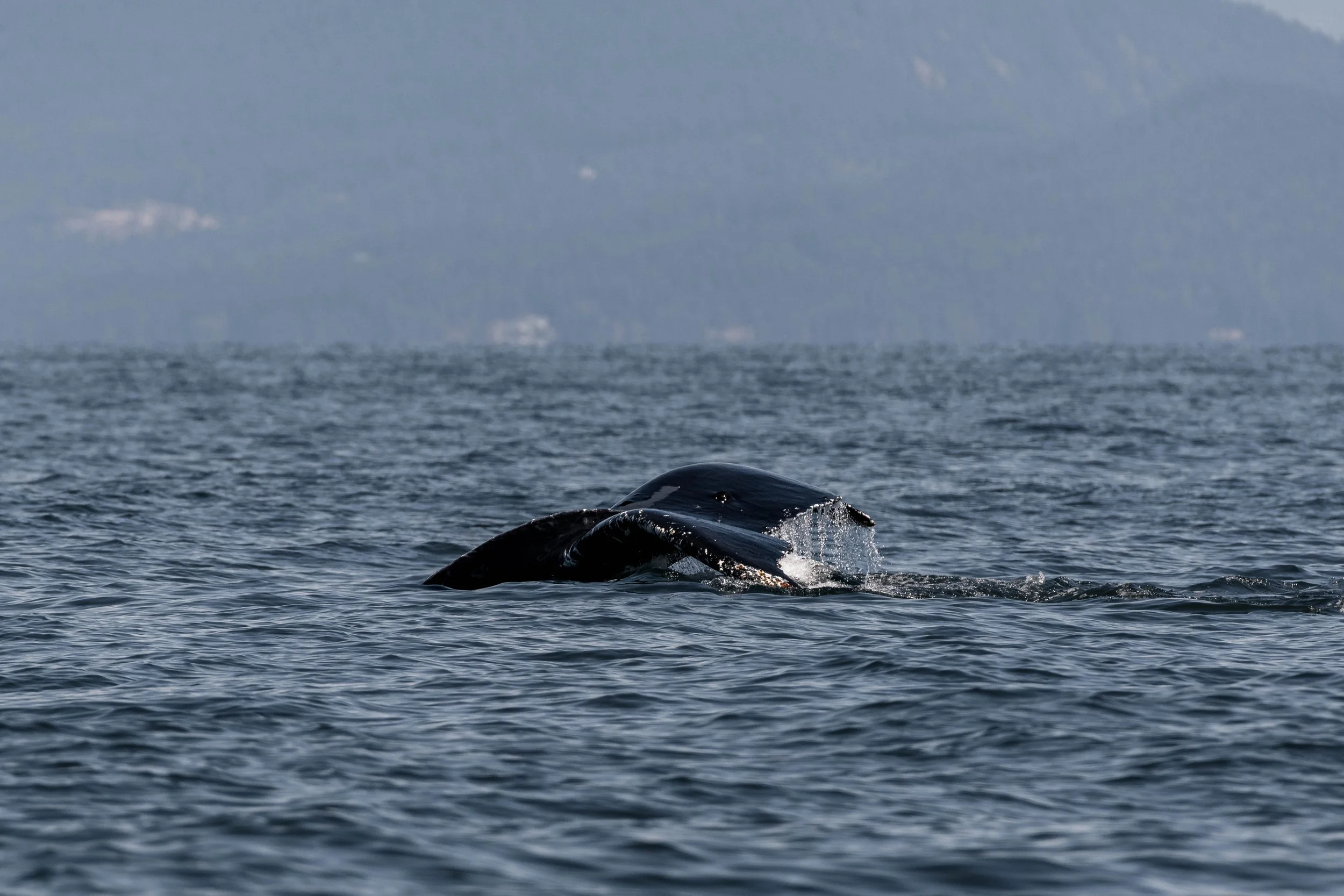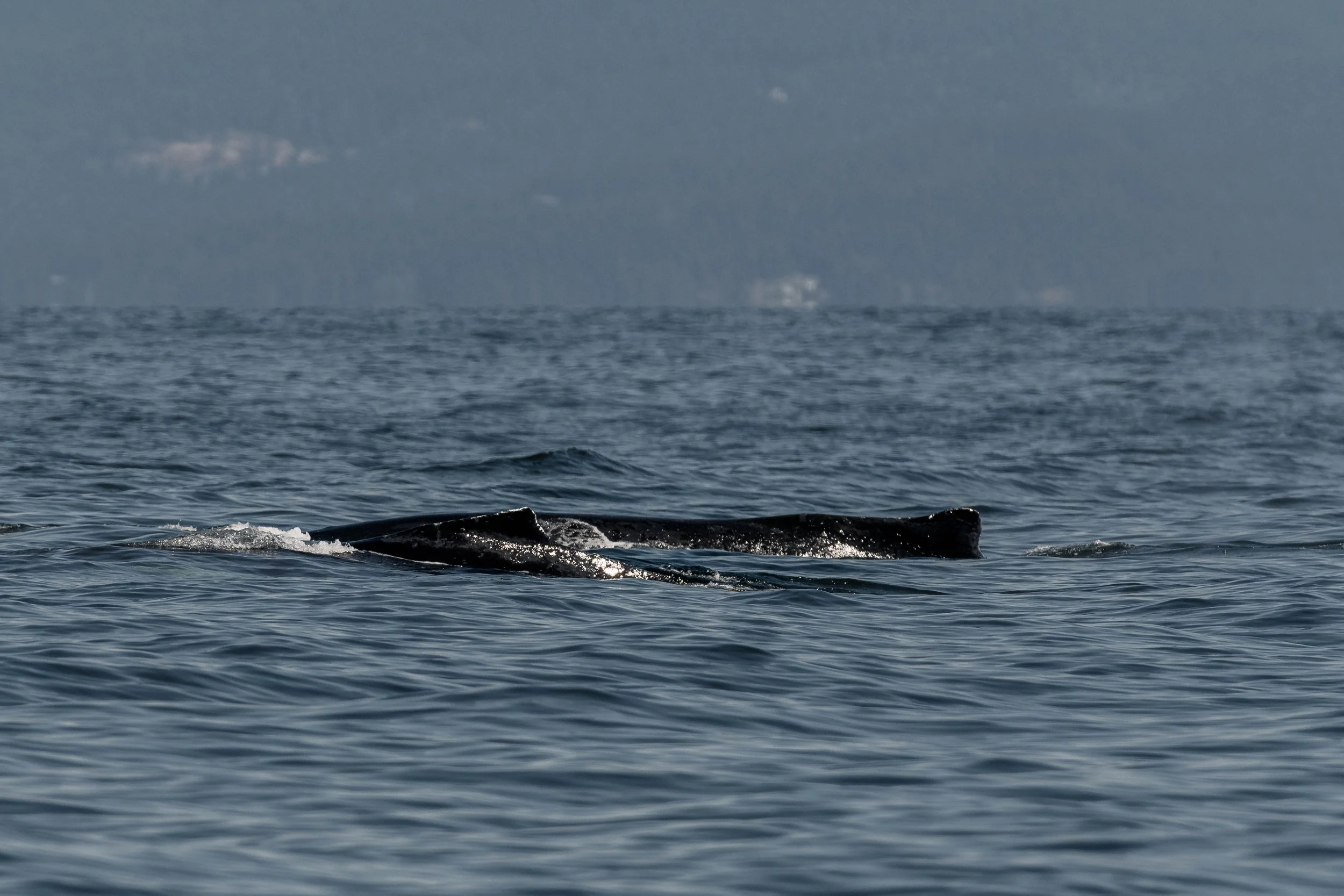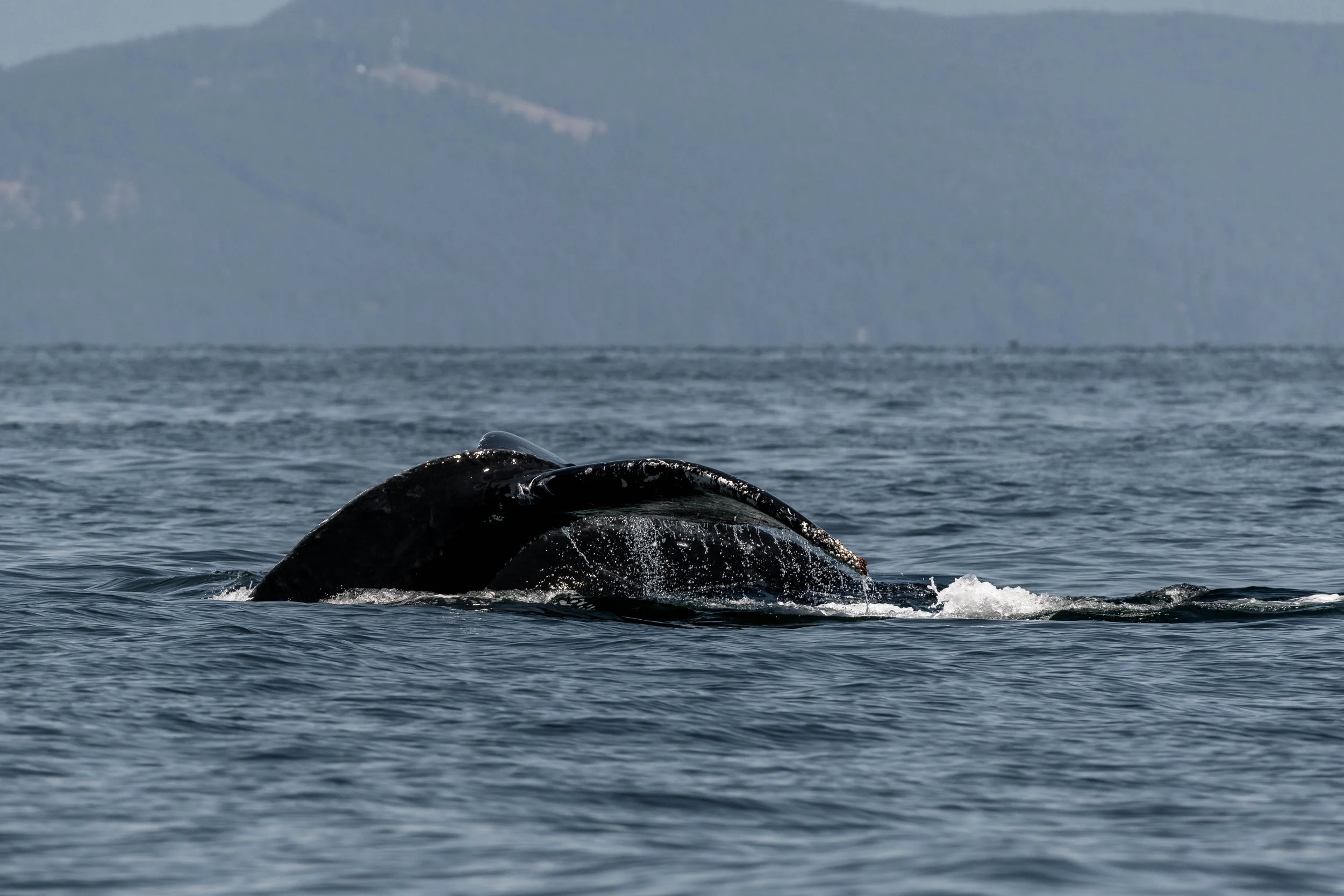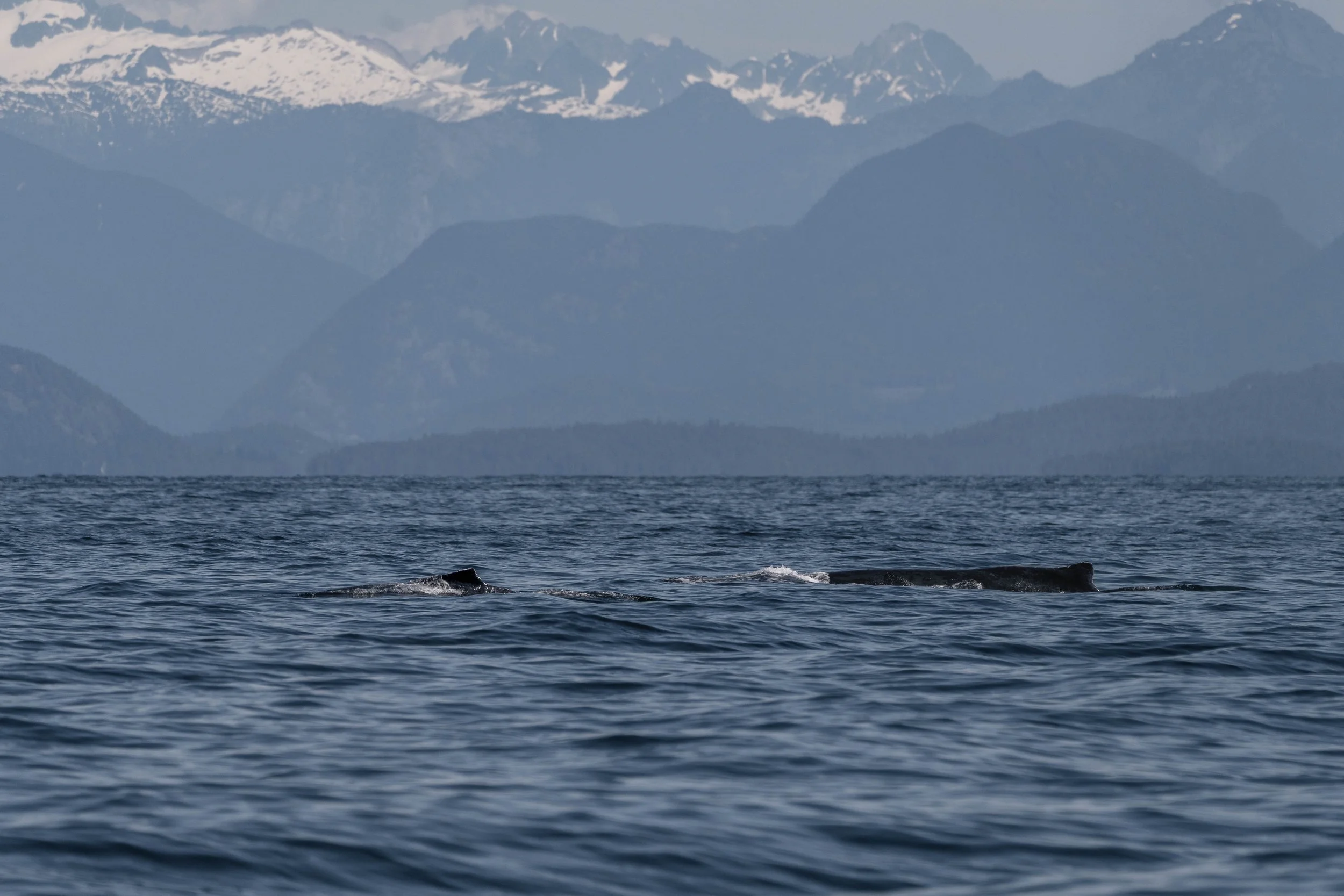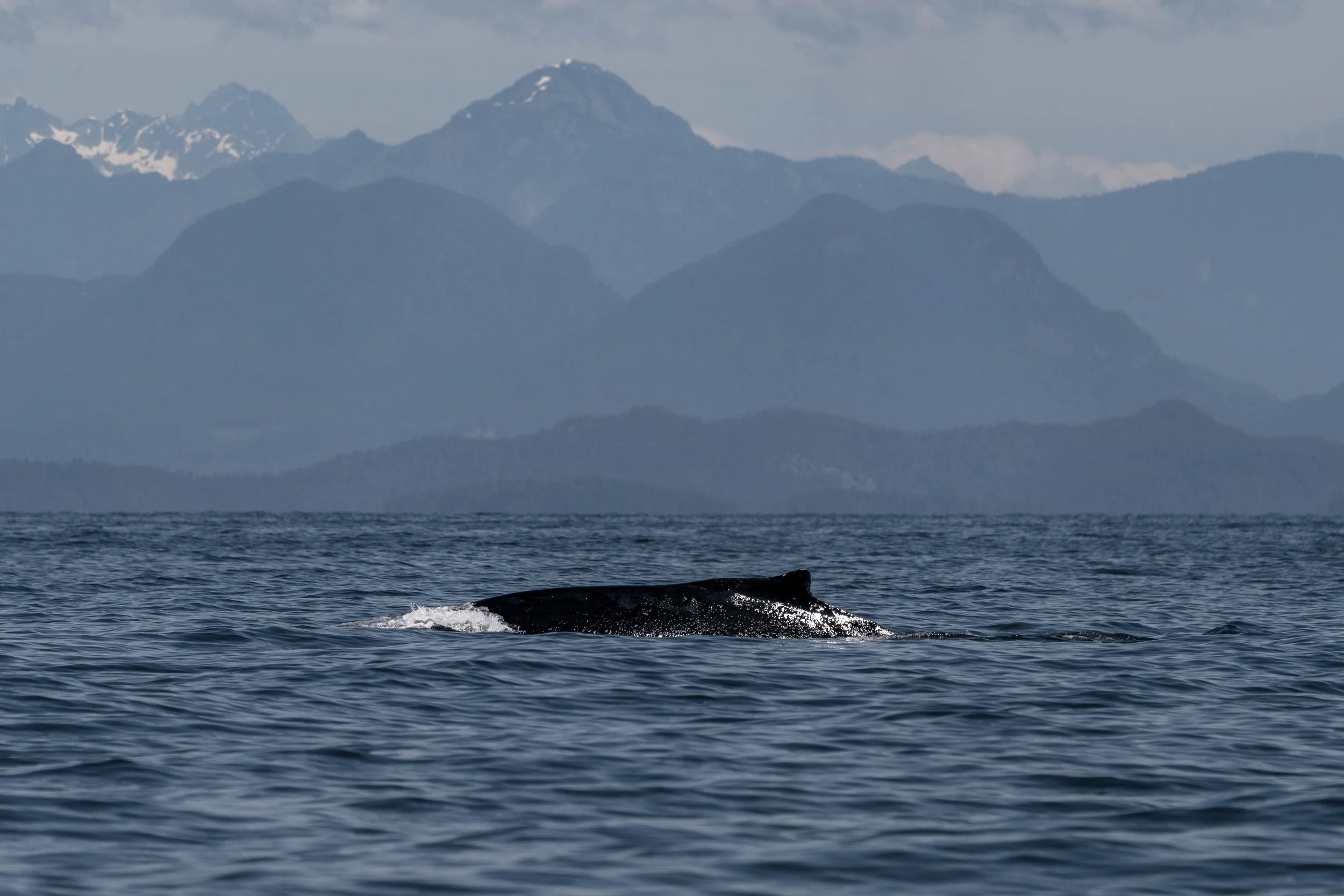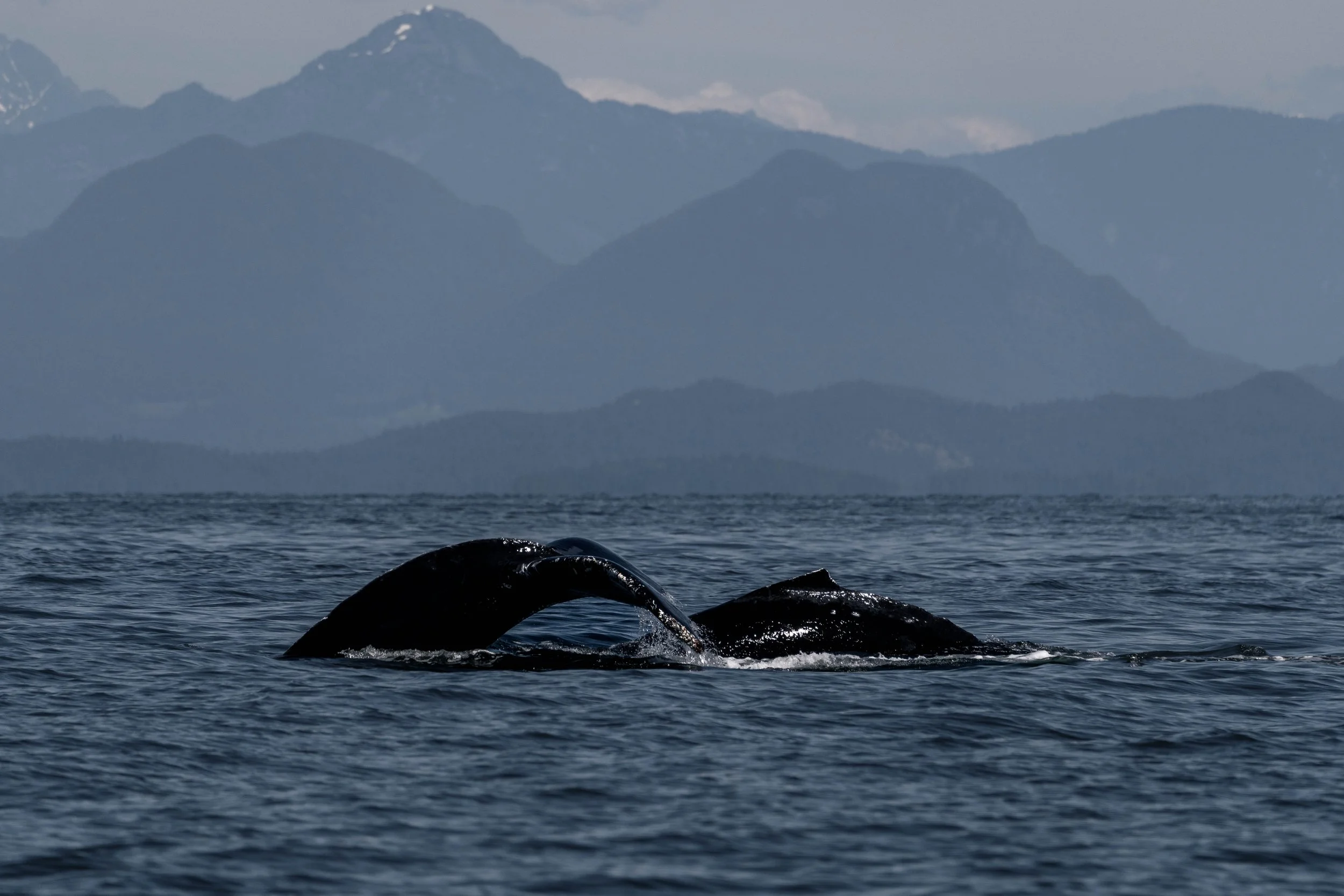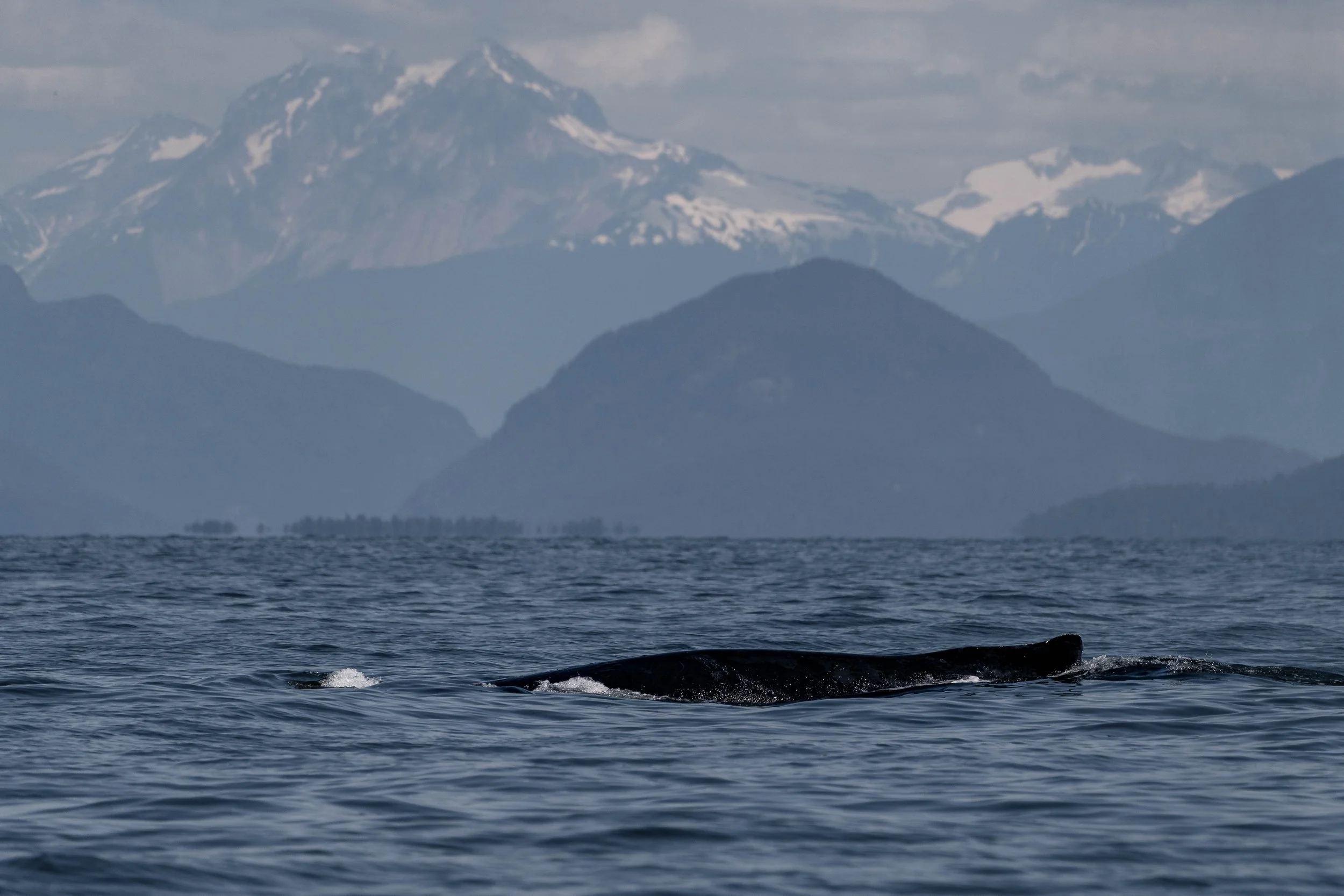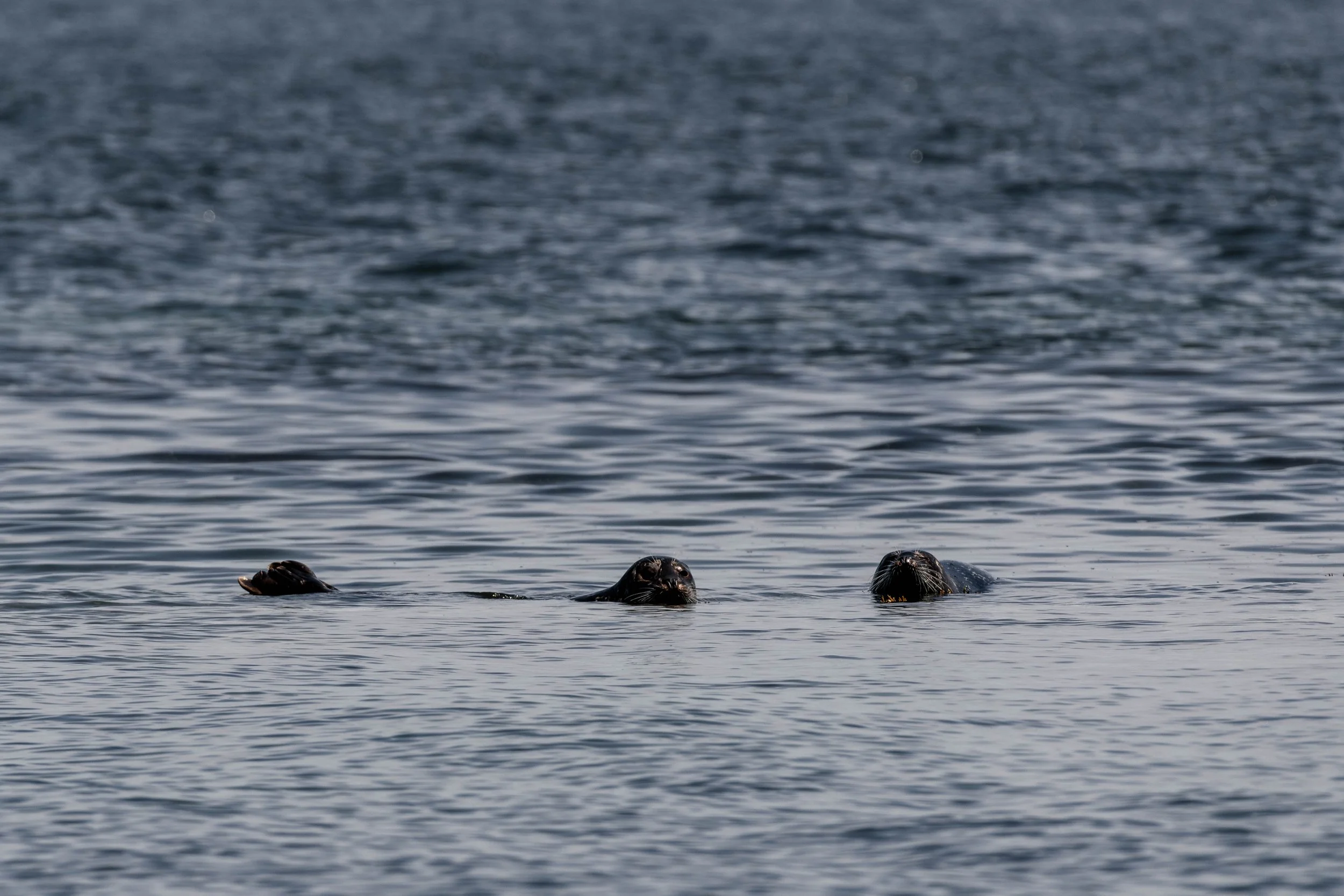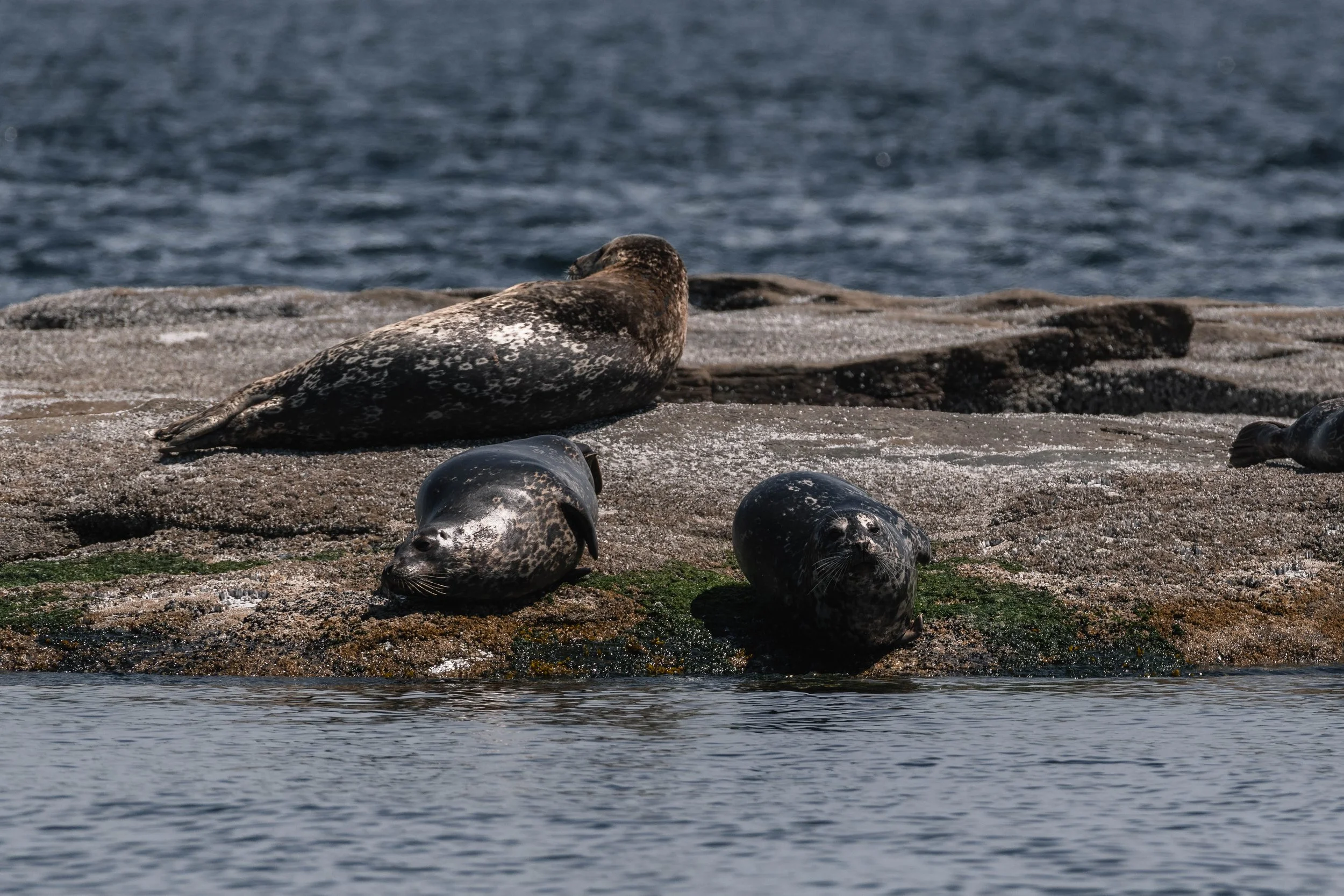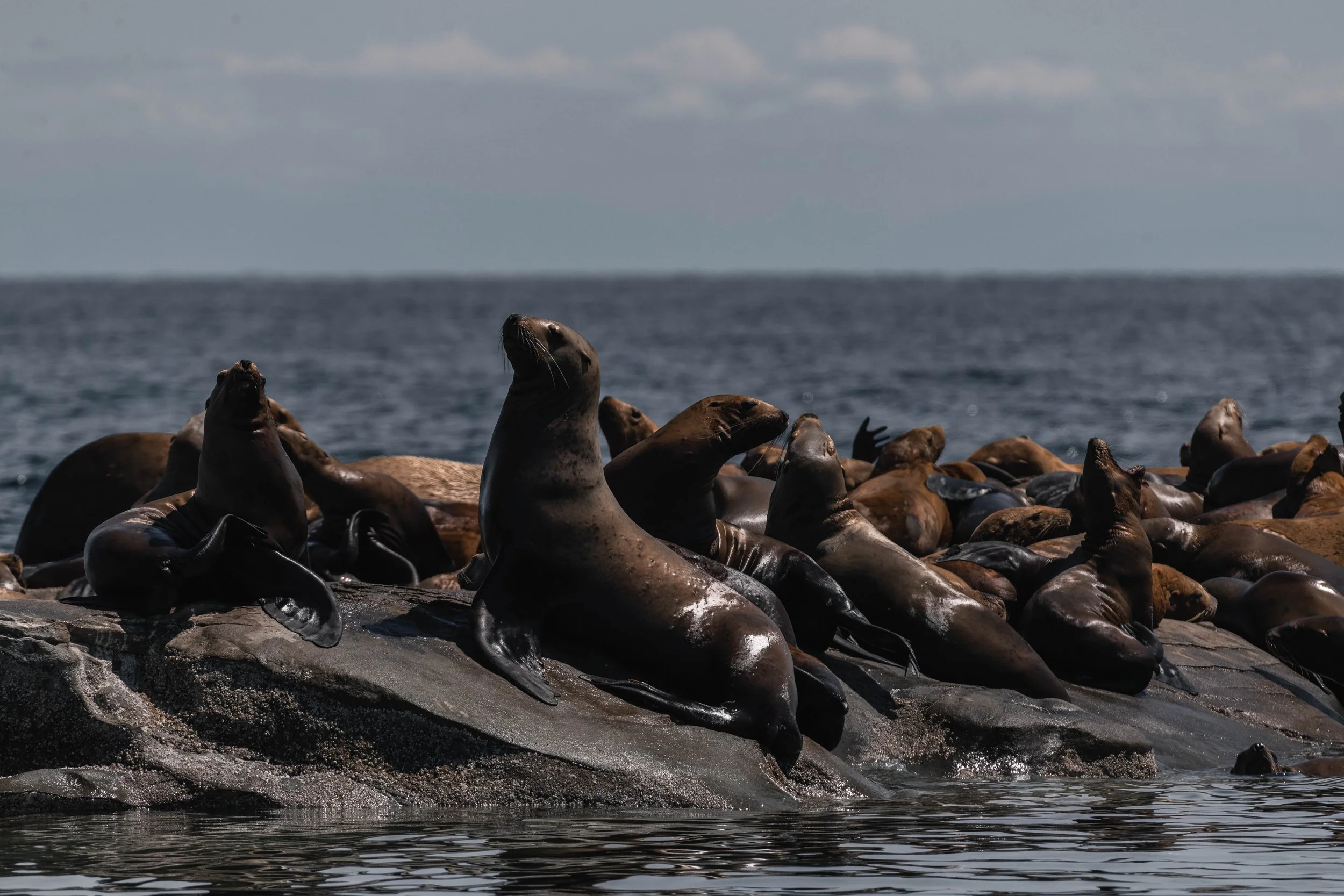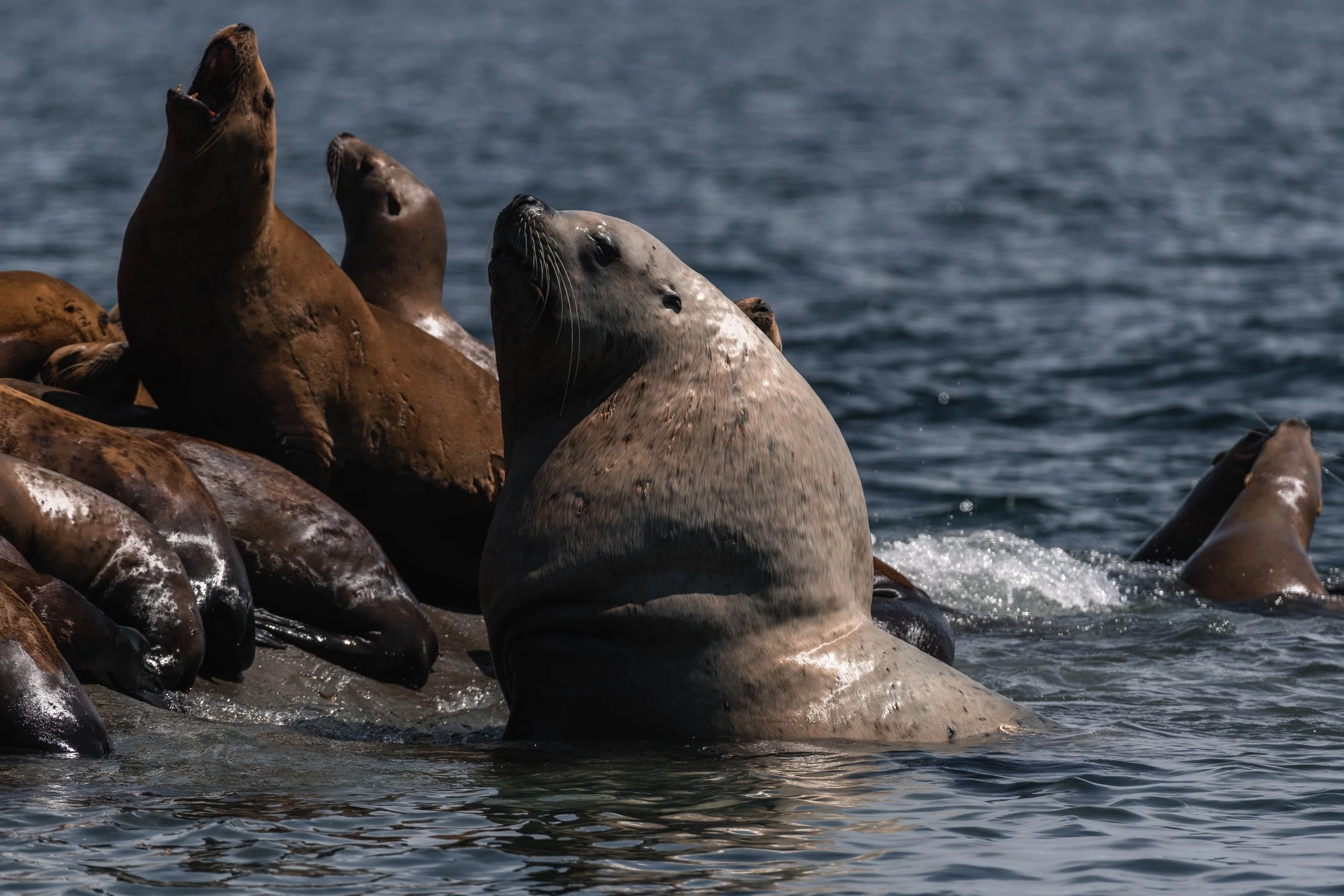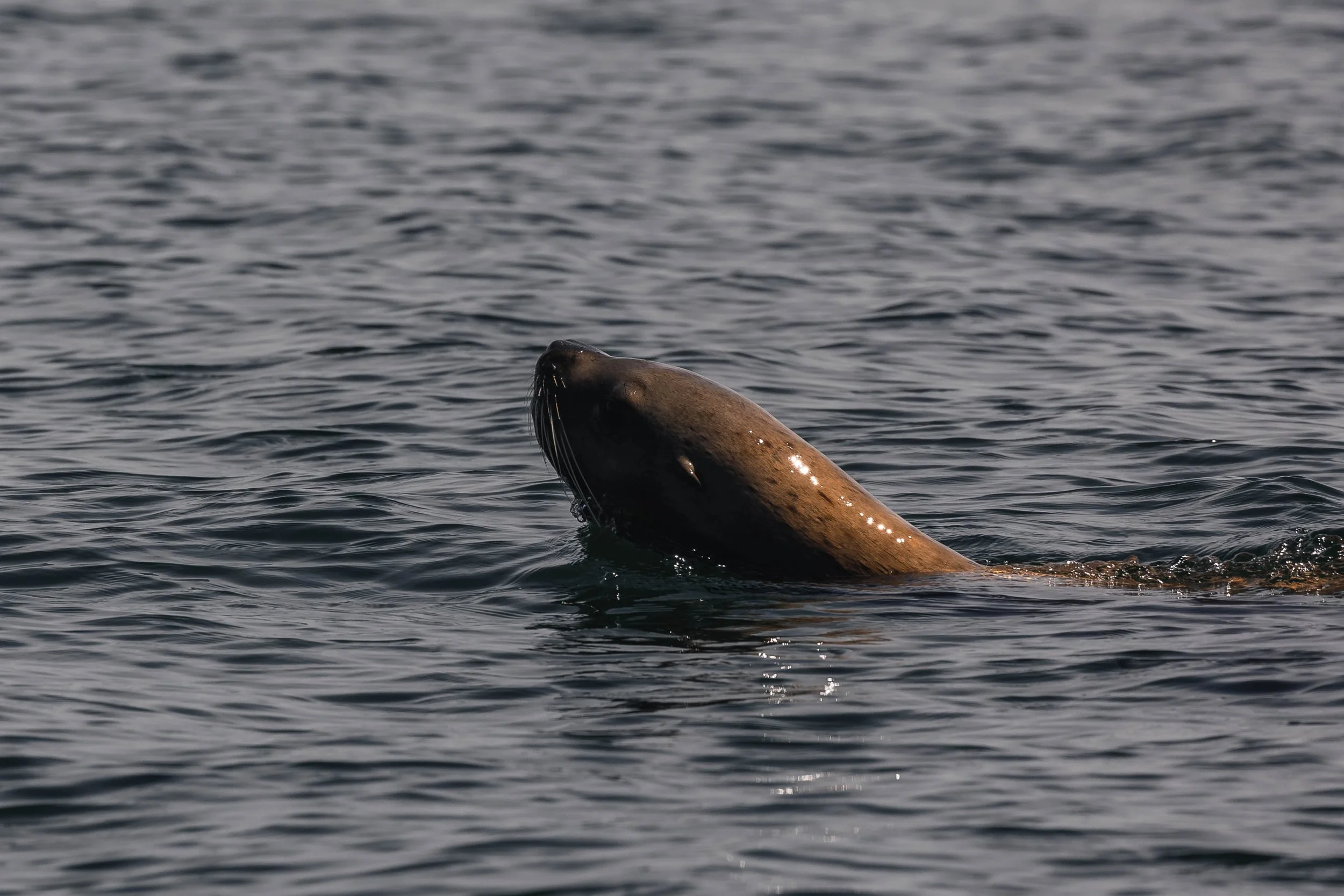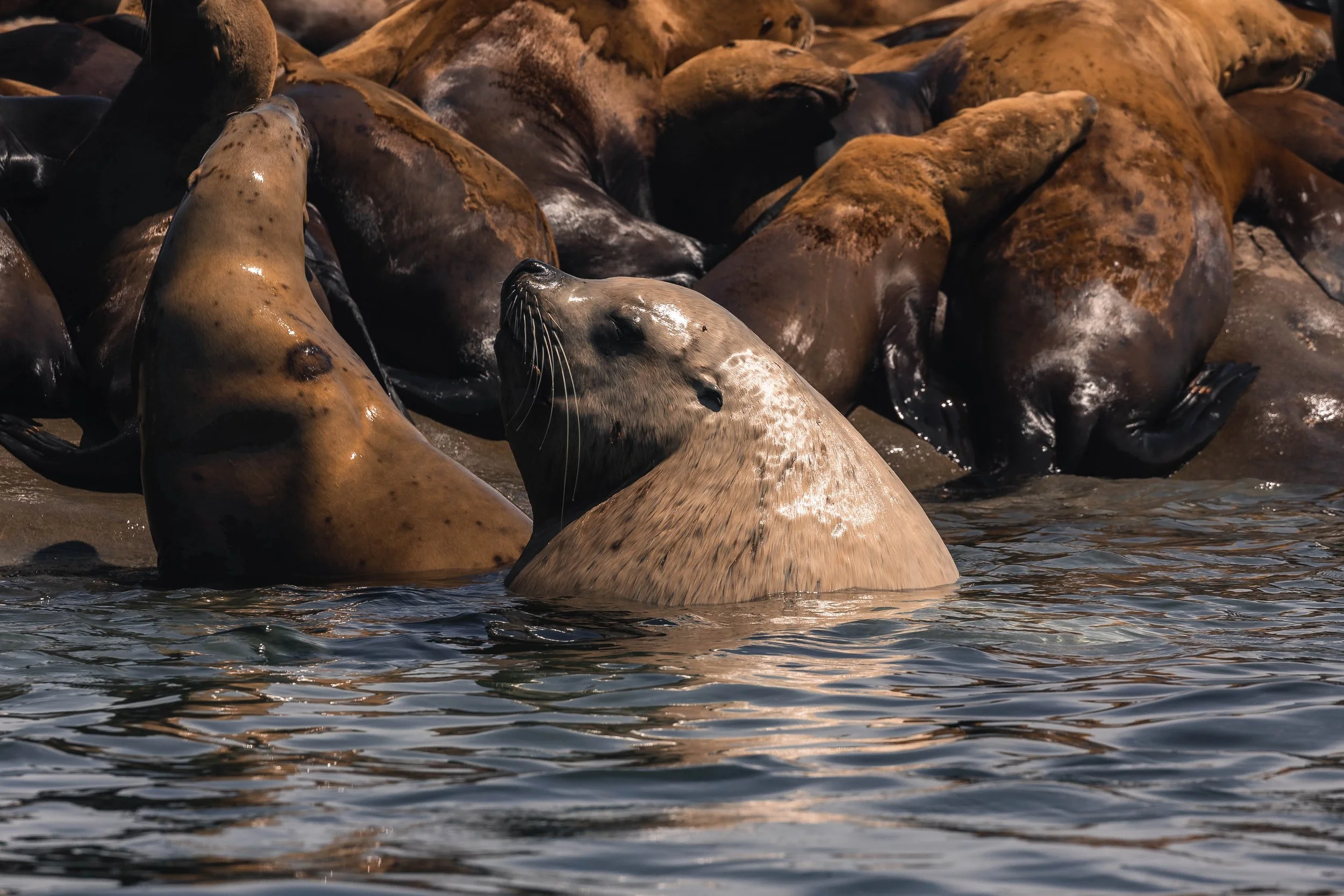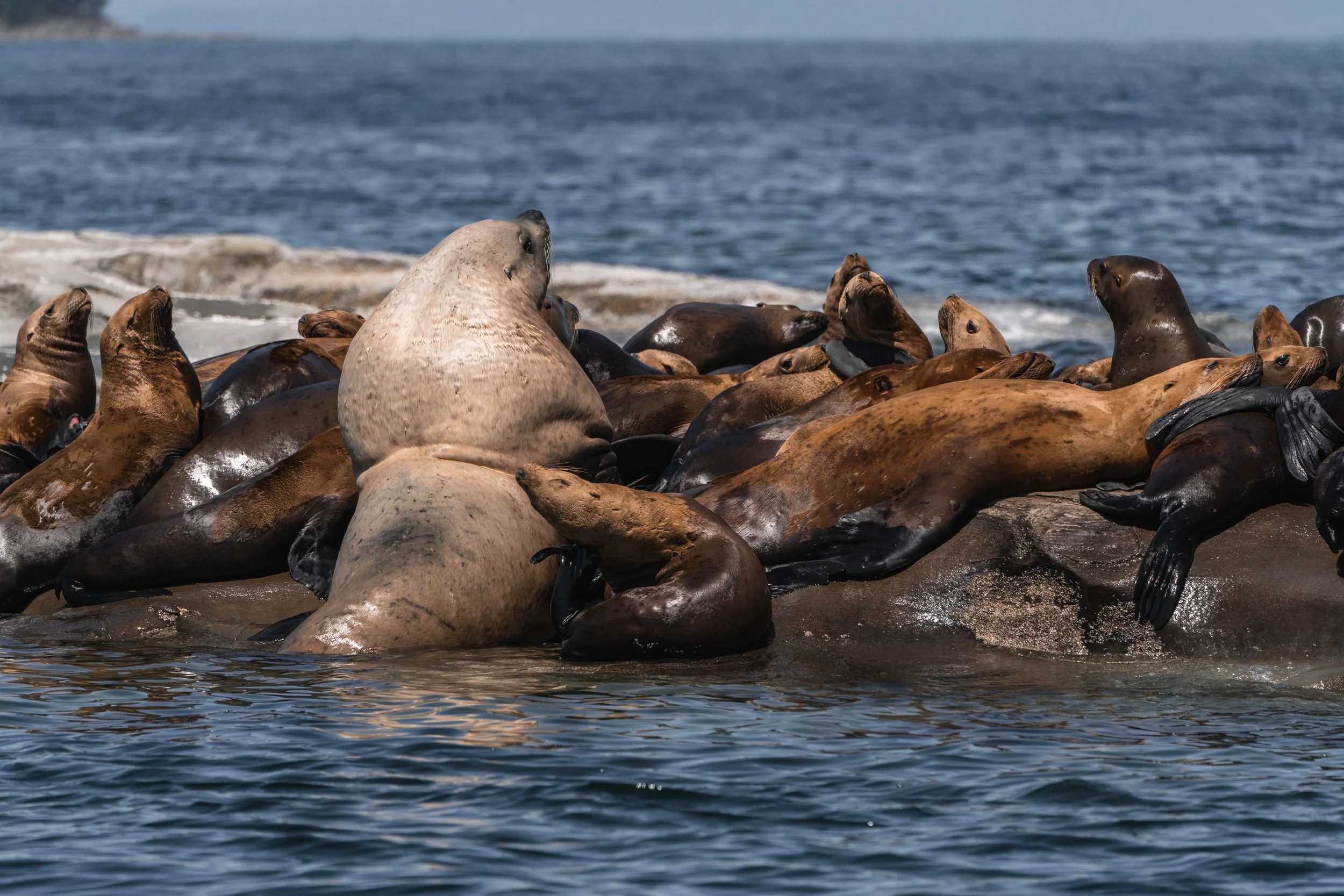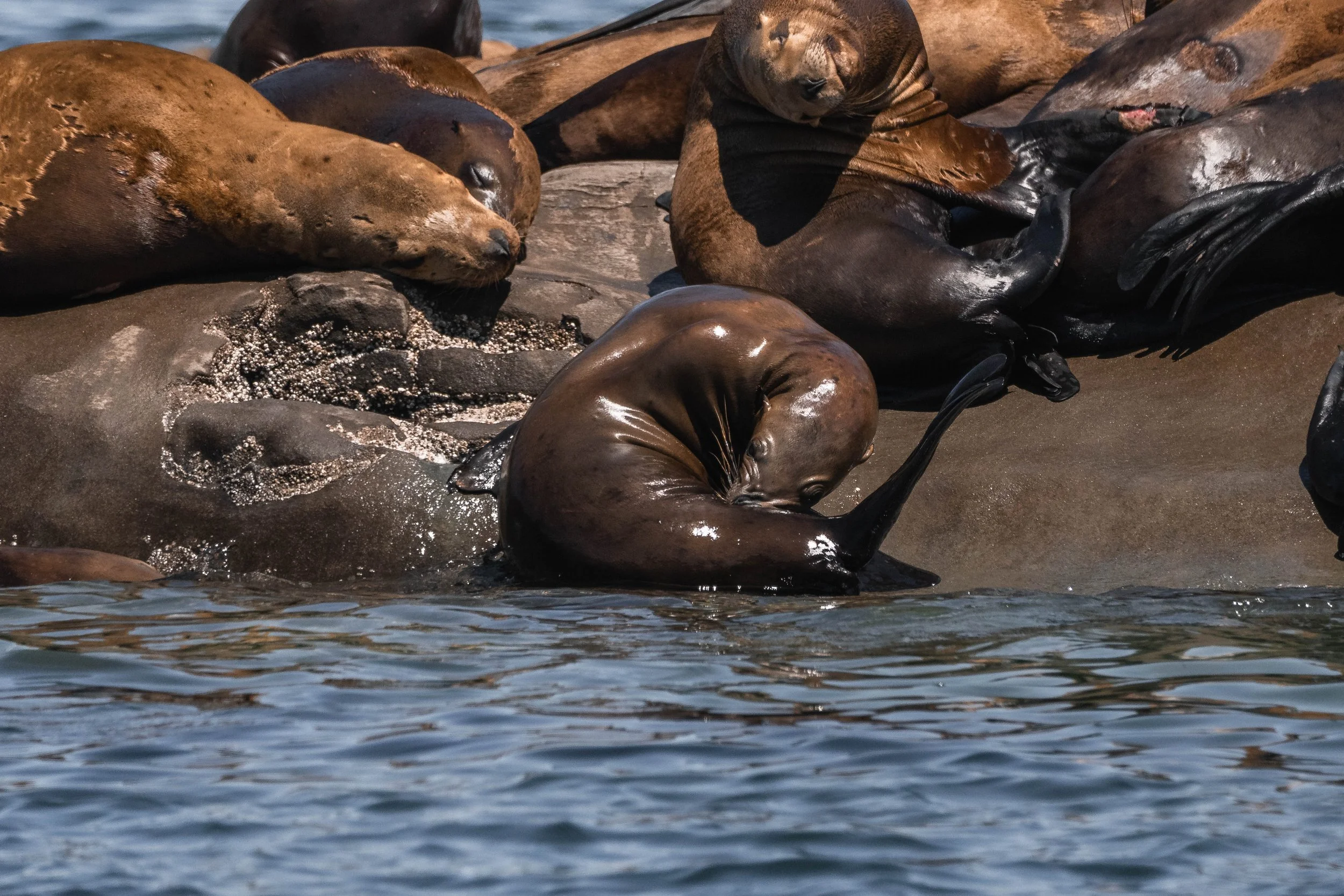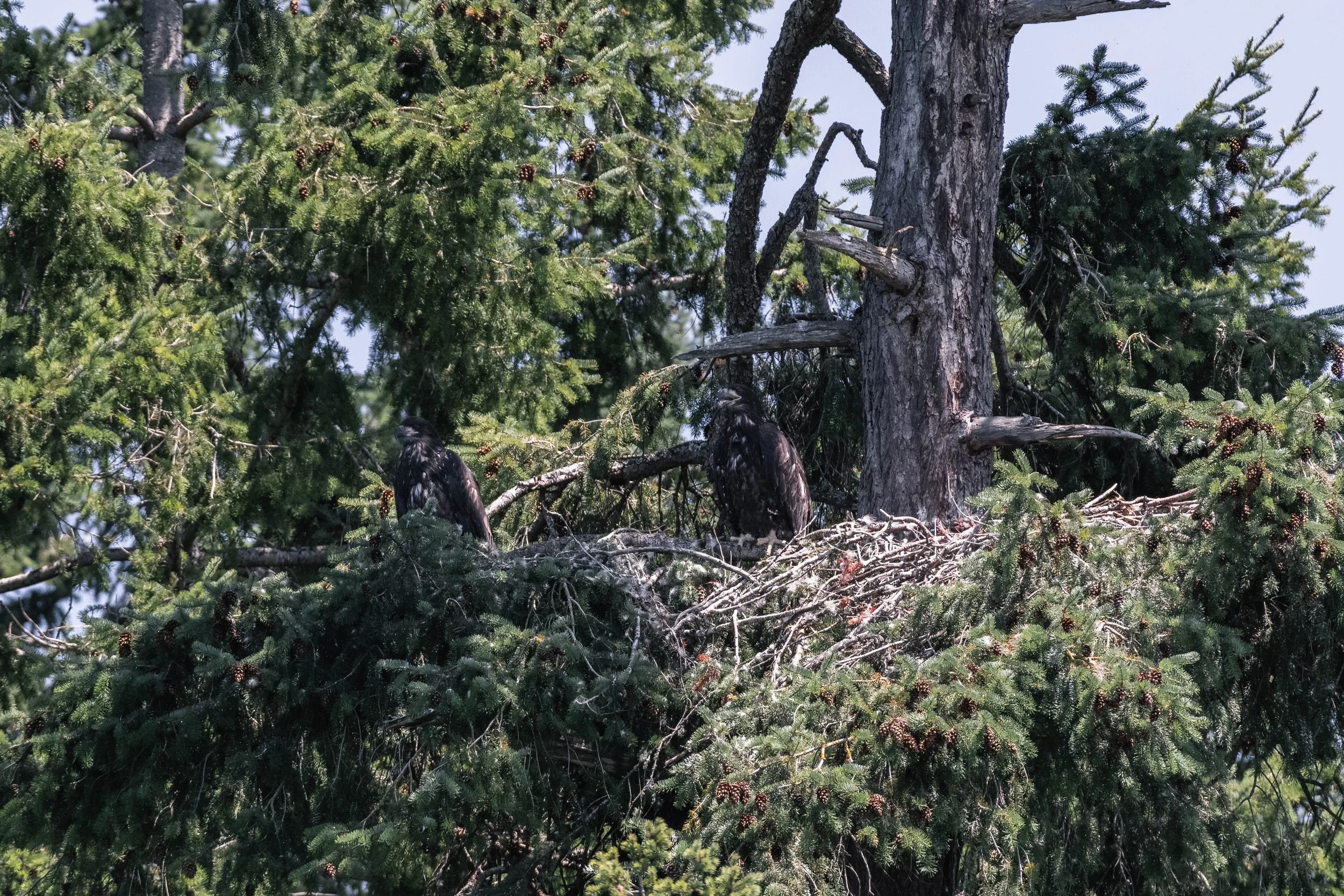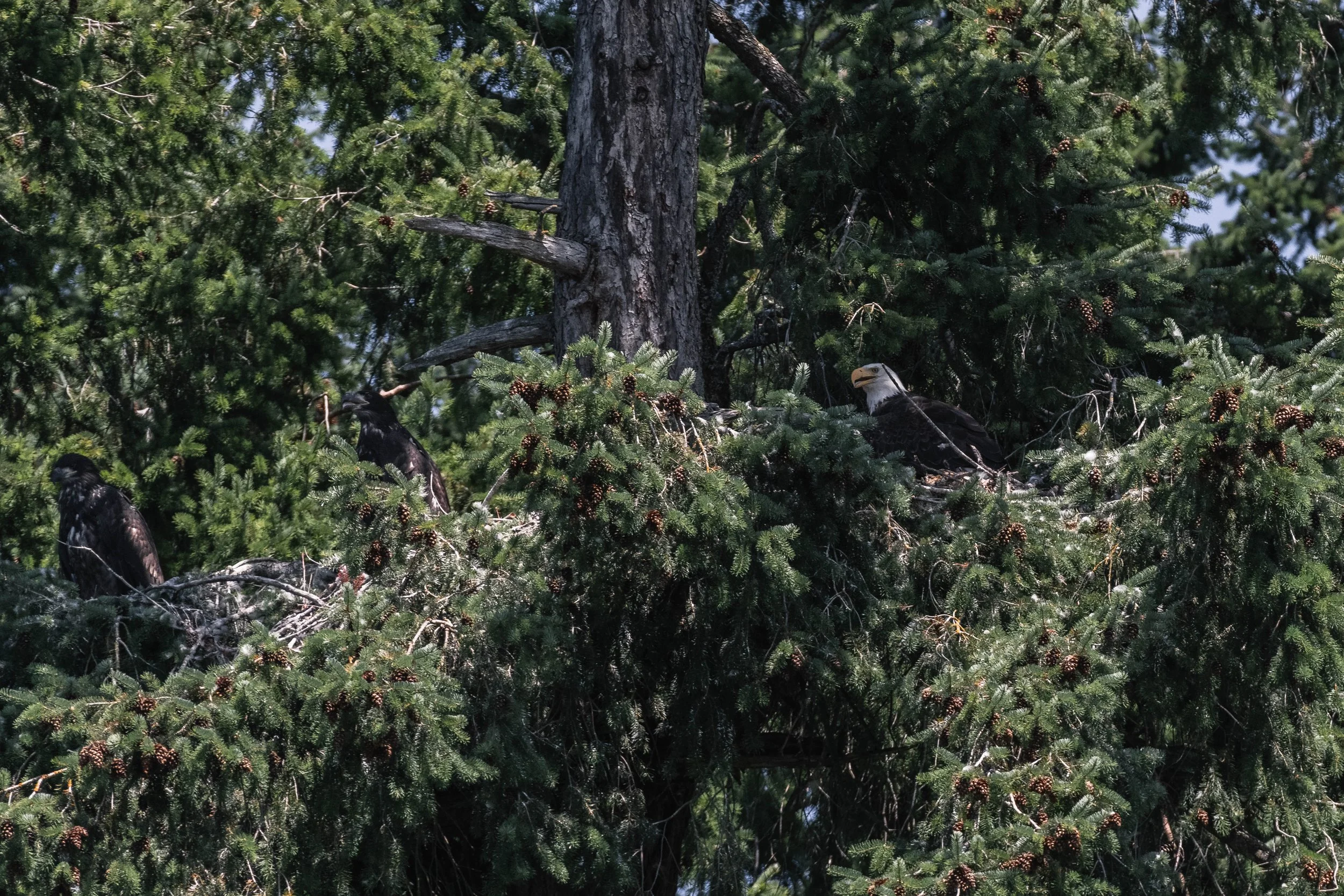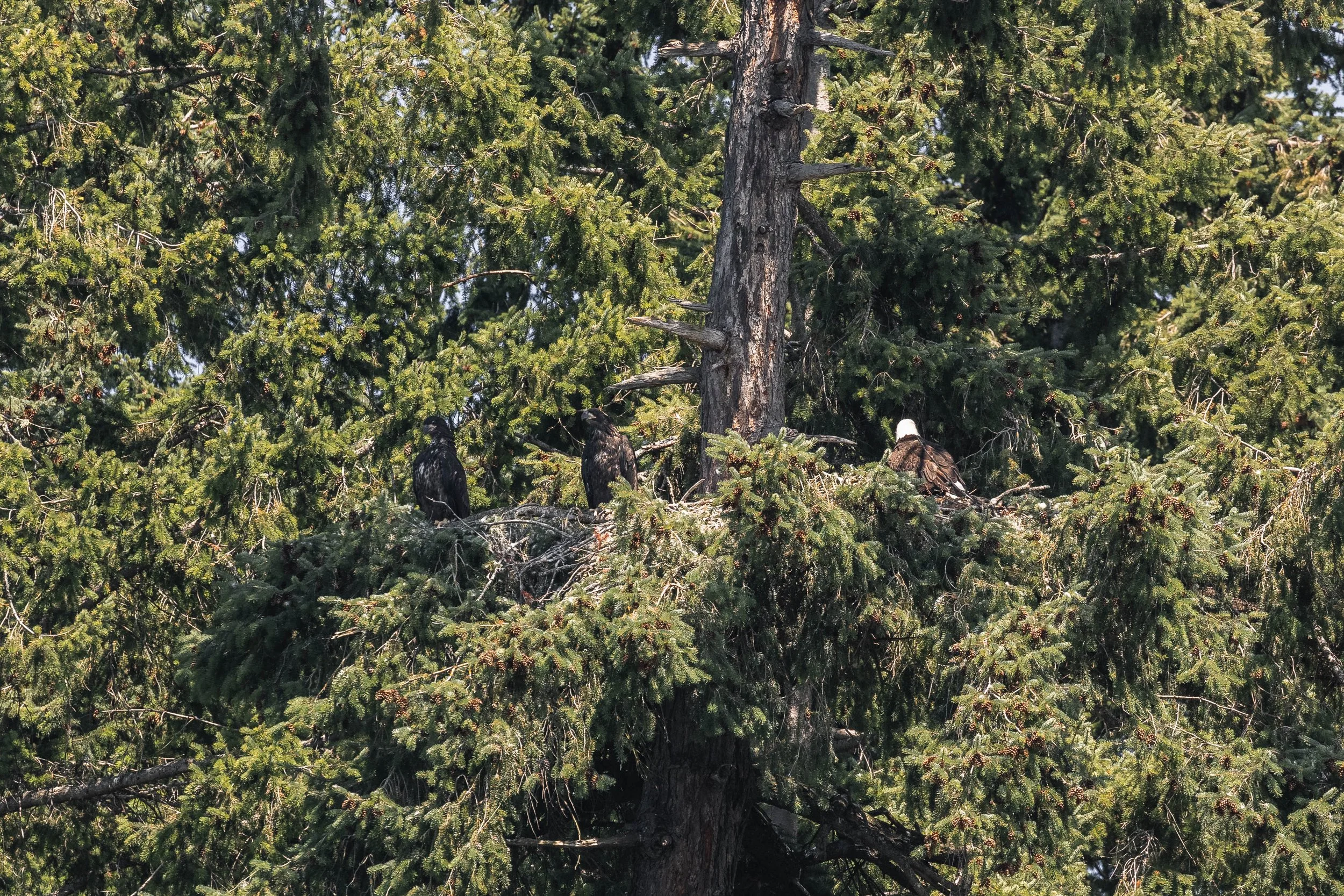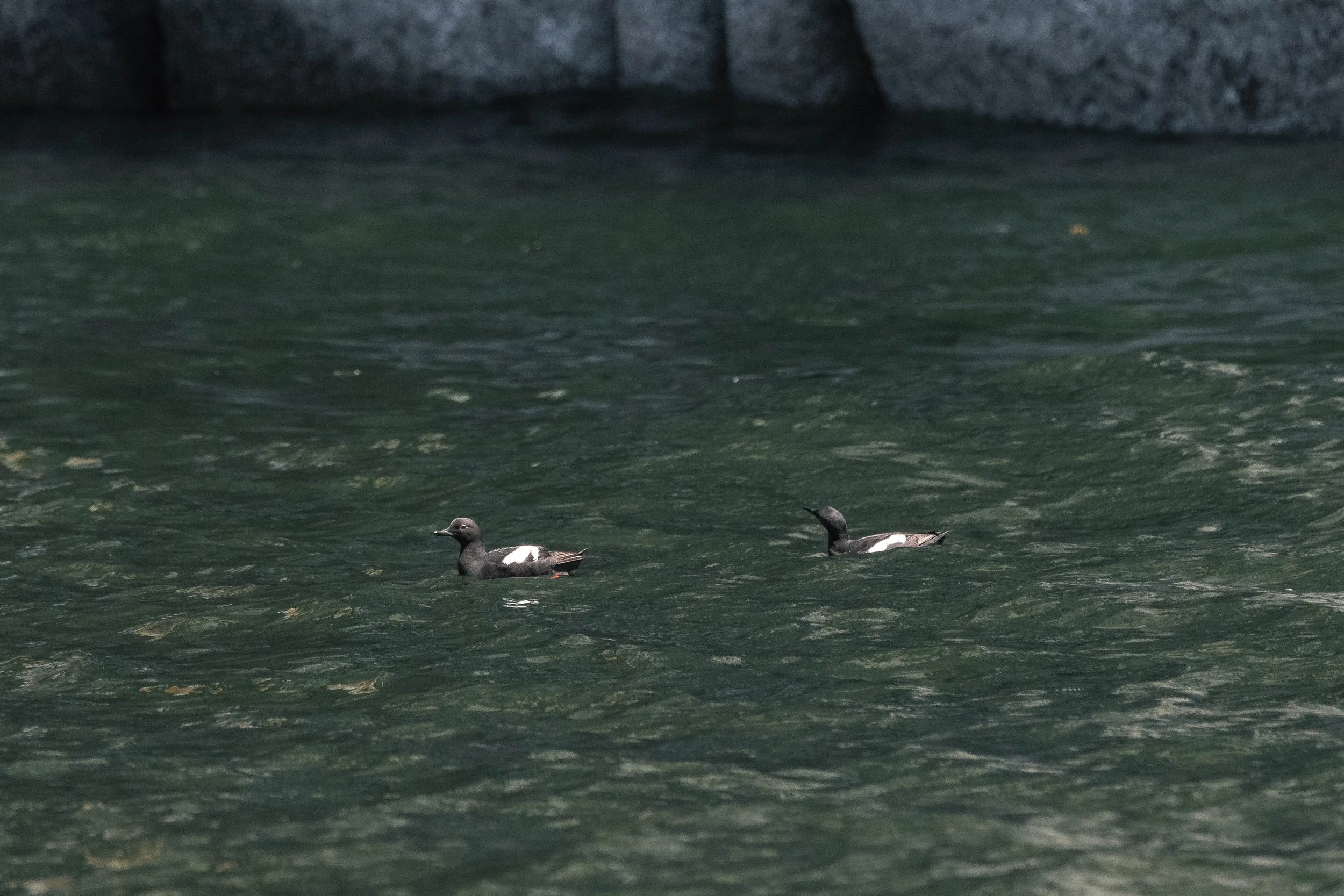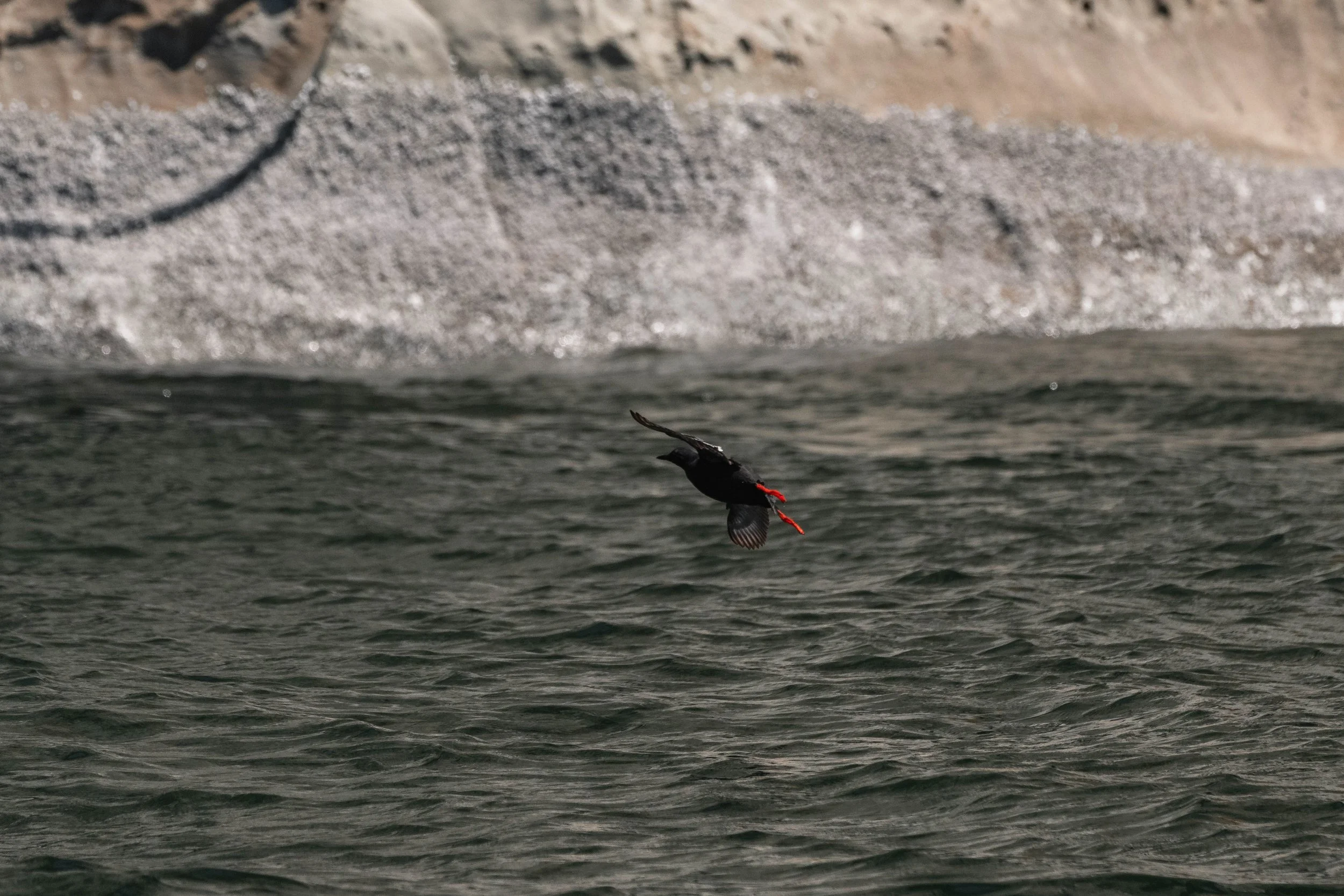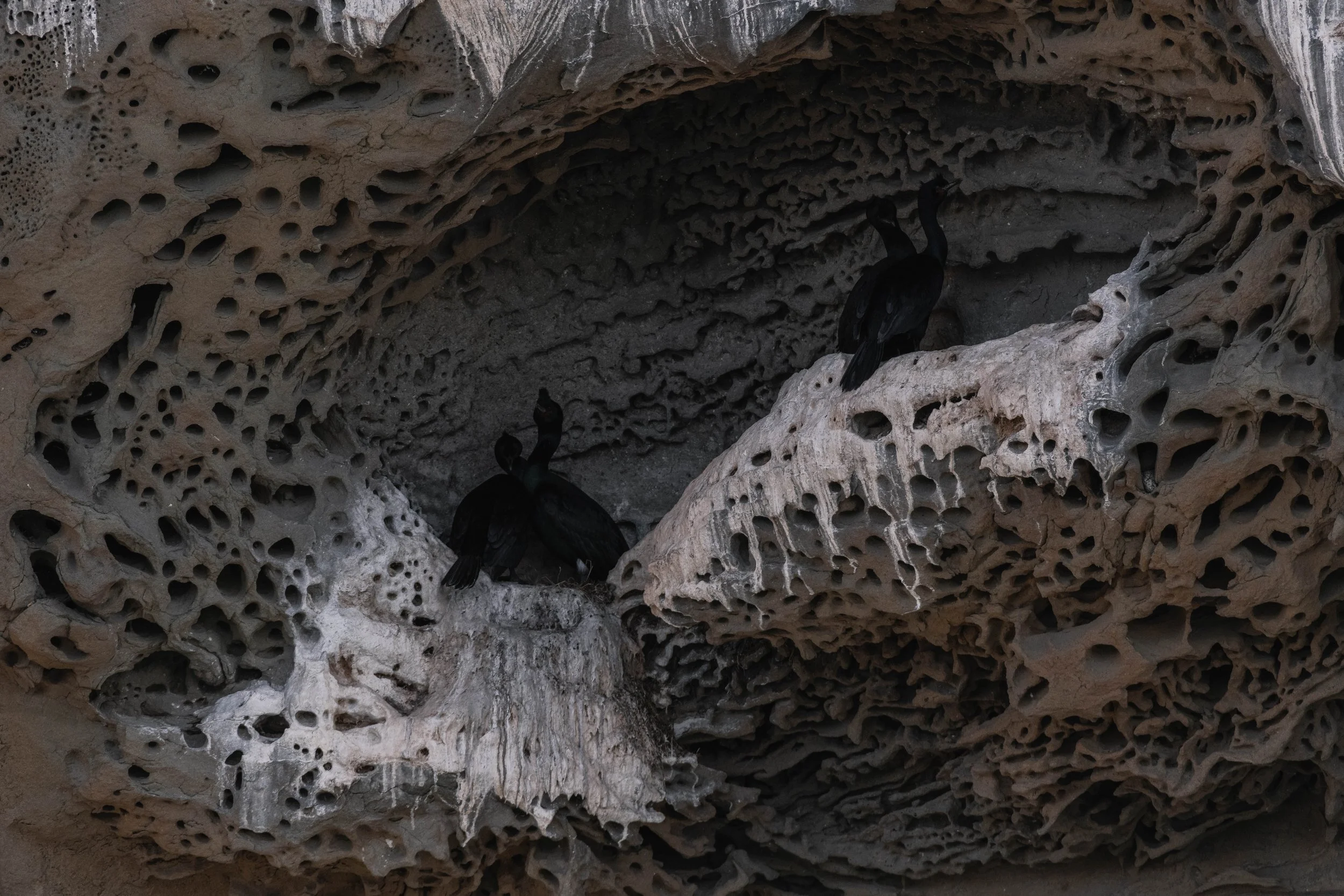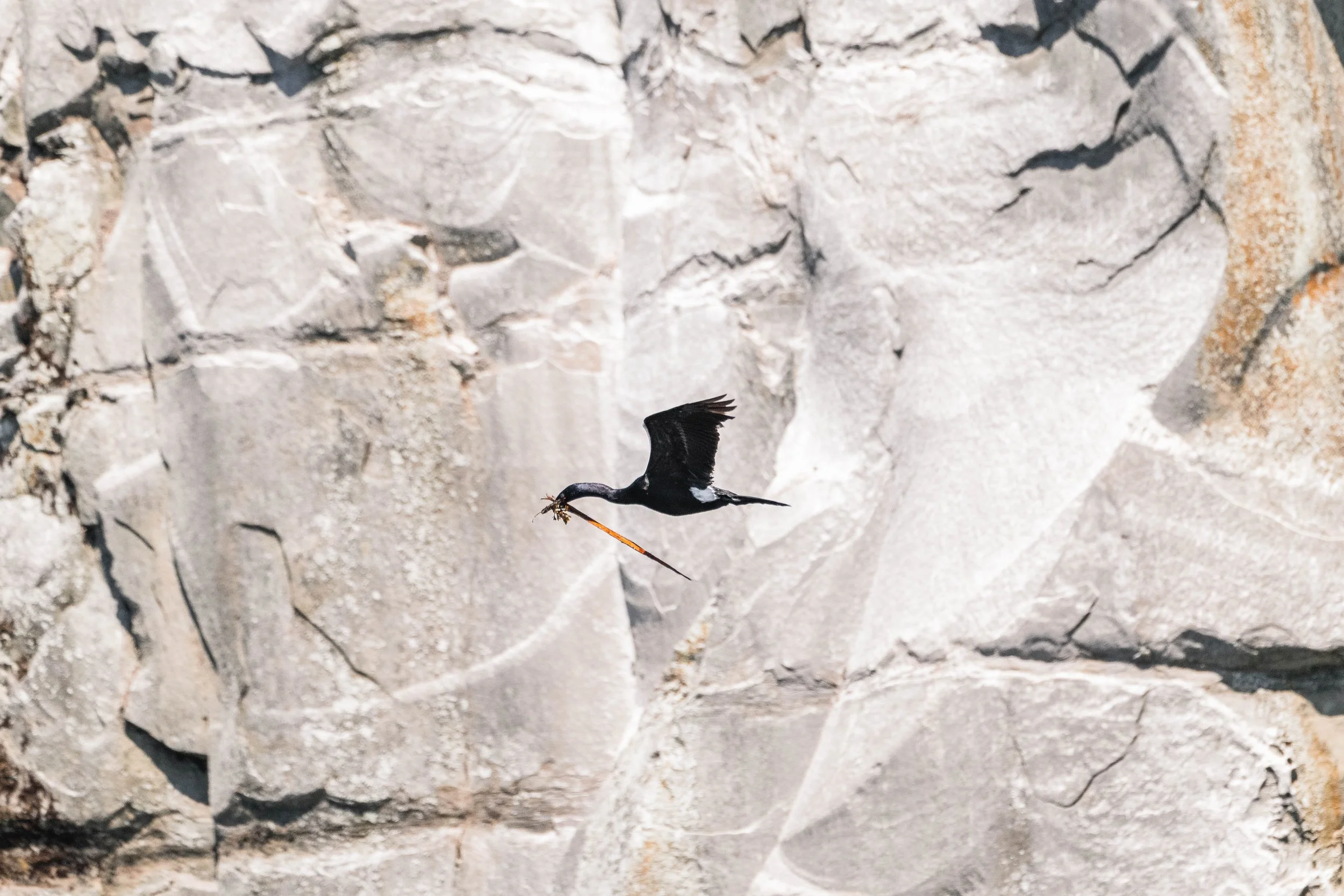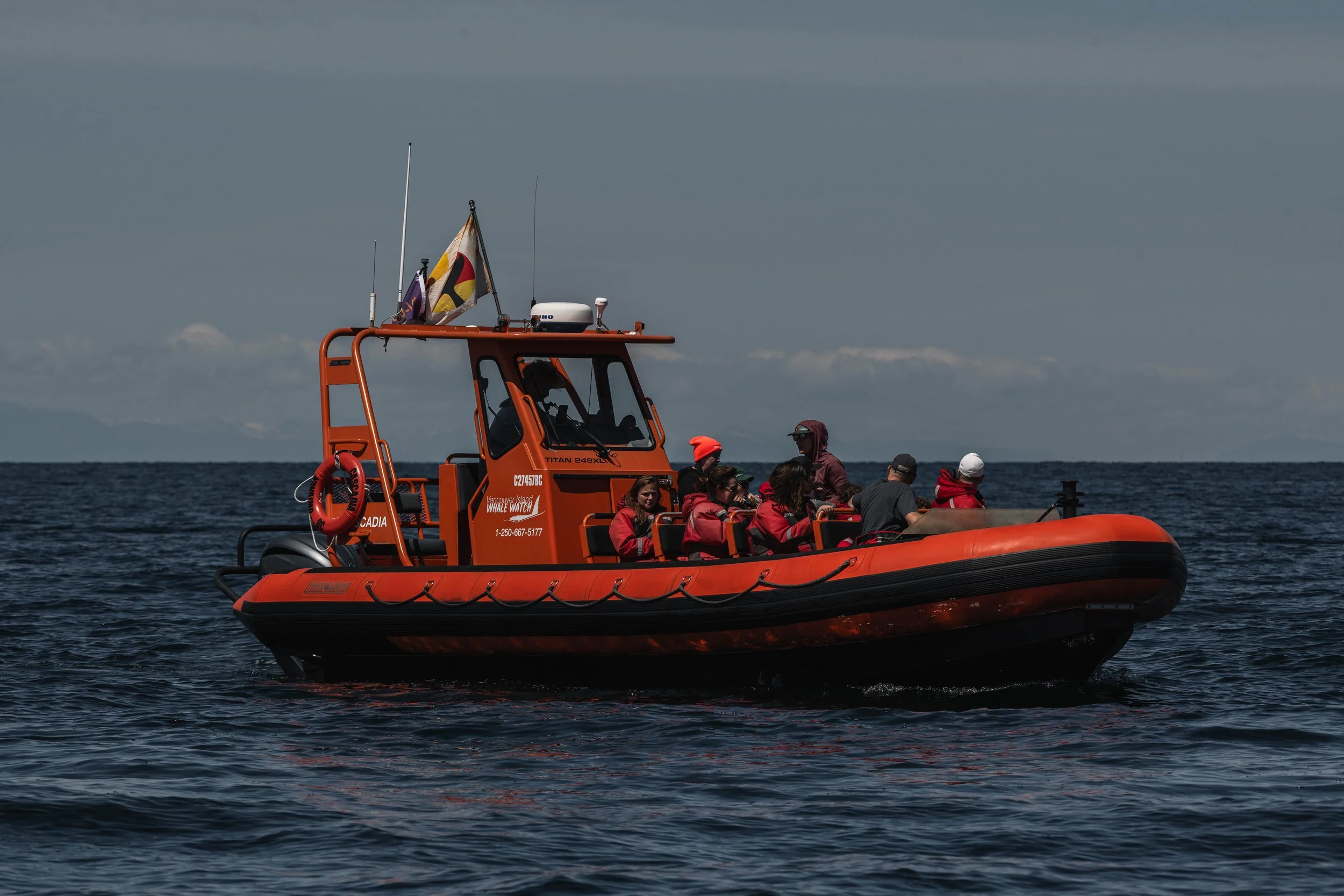July 4, 2025, 10:30 AM - Big Mama and her calf return to our area!!!
As we had three of our boats leaving Nanaimo on the morning of the 4th, we were excited to see what might be in store for us. There have been a lot of whales around lately, so we had our eyes peeled as we spread out the vessels to cover more ground.
The very first whale was spotted twice, once by each of the open boats at different times. Based on the dorsal fin and one clear tail shot, we recognized this whale as Lunchable (BCY1014calf2023). We have given them this temporary (for now?) nickname since they have a very clear “L” on the left side of their fluke, and it’s a fun processed breakfast food in line with their mom’s name, "Poptart”! Lunchable seemed to be feeding in the area, and we didn't stay around for too long since that meant very long dive times and sporadic surfacing.
The boats continued the search, and the semi-covered boat, along with one of the open boats, found another feeding humpback: Chandelle (BCX2140)! Once again, we didn’t stay too long with Chandelle due to the nature of feeding humpbacks. Since they are usually diving around 100 feet to feed on their favourite food sources: Krill and small schooling fish, it means they spend a fair amount of time beneath the surface. We also got word about another humpback whale not too far from where we were, and it might be one of the more famous whales in the area, so we couldn’t resist heading that way.
Soon enough, we spotted the blows in the distance: a pair, one big and one small. It was Big Mama (BCY0324) and her 8th calf! These two were looking very peaceful, travelling together. We didn’t see much in the way of flukes during our time with them, but we did get enough to confirm her ID. We don’t usually mind the lack of fluking, though, since it typically means that there is more time with the whales at the surface instead of diving deep for their food. Big Mama is well known in the whale watching industry due to her being one of the first whales that returned to our waters after the end of the whaling era, and because of all the calves that she has been bringing back to the area. Since humpbacks have very high site fidelity, meaning they come back to the same general area year after year, these calves are helping to increase the local population of whales! 8 calves is a very impressive number, and even more impressive is that Big Mama is a great-great-grandmother, with her family tree having 20 members, including herself. That is a lot of whales! We always enjoy seeing her during our tours, and even more so when she has one of her cute little babies with her!
But we can’t stay with the whales forever (even though we might want to), so we left her and the calf behind and started towards a nearby haul-out site: Stinky Rocks! Stinky Rock is usually full of activity, from the Steller Sea Lions arguing on the rocks, to a variety of birds that enjoy using the area for resting or for swimming around, looking for a fishy snack. The Sea Lions usually steal the show here, though, since they are usually acting quite entertaining. Not just fighting amongst each other, but sometimes watching curiously from the water, jumping from the rocks, and usually growling back and forth to each other. Sometimes people think that we are causing the interactions amongst the Sea Lions, but anyone who lives close to one of the sites will tell you that they are constantly that noisy, even when we aren’t around.
After departing from the ever-aromatic Stinky Rock, our boats meandered along a scenic route back to Nanaimo, weaving through the stunning Southern Gulf Islands. We passed through the narrow, current-swirled corridor of Dodd Narrows and made a few delightful detours to check in with some local wildlife along the way.
Our first stop was a Bald Eagle’s nest perched high above the shoreline, where we were lucky enough to spot three family members at home. Bald Eagles don’t develop their iconic white head and tail feathers until they’re around five years old, so it was easy to tell that we had one of the proud parents alongside two juvenile eaglets from the 2025 season—still dark-feathered and a little scruffy, but no less majestic.
From there, we cruised past the Gabriola Bluffs, a rugged cliffside that plays host to a bustling community of seabirds. Most prominent among them were the cormorants. These sleek, fish-loving birds have uniquely adapted to life below the waves. Unlike most birds, cormorants produce very little preen oil—an oily substance typically used to waterproof feathers. Without it, they become less buoyant, which actually works in their favour: it allows them to dive deep in search of food, sometimes plunging over 100 feet below the surface. After a good dive, you'll often spot them perched with wings outstretched, drying off in the breeze.
It was a day filled with hidden gems and wildlife surprises—another reminder of just how rich and wild our backyard truly is. Please enjoy the photos below, taken by Aly Kohlman, Val Watson and Hayleigh Hilbert.
Lunchable going for a dive. Photo by Hayleigh Hilbert.
The underside of Lunchable’s tail. Photo by Hayleigh Hilbert.
Lunchable surfacing in the waves. Photo by Val Watson.
The underside of Chandelle’s tail. Photo by Hayleigh Hilbert.
Big Mama’s dorsal fin as she surfaces. Photo by Aly Kohlman.
Big Mama’s calf surfacing. Photo by Aly Kohlman.
Big Mama splashing through a wave. Photo by Aly Kohlman.
Big Mama arching for a dive. Photo by Aly Kohlman.
Big Mama lifting her tail to dive. Photo by Aly Kohlman.
The new calf surfacing in front of Big Mama. Photo by Aly Kohlman.
Big Mama diving with her calf just behind. Photo by Aly Kohlman.
The underside of Big Mama’s tail. Photo by Hayleigh Hilbert.
Big Mama lifting her tail to dive with her calf just in front of her. Photo by Hayleigh Hilbert.
Big Mama (back) and calf (front) surfacing together. Photo by Val Watson.
Big Mama in front of the Coastal Mountains. Photo by Val Watson.
A great look at Big Mama. Photo by Val Watson.
Big Mama lifting her fluke to dive as the calf arches next to her. Photo by Val Watson.
Big Mama creating a wave as she moves through the water. Photo by Val Watson.
A couple of Harbour Seals watching from the water. Photo by Aly Kohlman.
Some harbour seals on Stinky Rock. Photo by Aly Kohlman.
Some very round Harbour Seals on the rocks. Photo by Hayleigh Hilbert.
Steller Sea Lions on Stinky Rock. Photo by Aly Kohlman.
Stinky Steve keeping an eye on things. Photo by Aly Kohlman.
Steller Sea Lion swimming by. Photo by Hayleigh Hilbert.
Stinky Steve watching us from the water. Photo by Hayleigh Hilbert.
Steve jumping into the water. Photo by Hayleigh Hilbert.
One of the Big boys relaxing in the water. Photo by Val Watson.
Steller Sea Lions hanging out on Stinky Rock. Photo by Val Watson.
A very itchy Steller Sea Lion. Photo by Val Watson.
Rawr! Photo by Val Watson.
The Bald Eagles on the nest.Photo by Aly Kohlman.
A watchful parent on the nest with the babies. Photo by Aly Kohlman.
Two young eagles watching from the nest with their parent nearby. Photo by Hayleigh Hilbert.
A Pigeon Guillimot floating by. Photo by Aly Kohlman.
Pigeon Guillimots floating by at the Gabriola Bluffs. Photo by Val Watson.
Look at their little orange feets! Photo by Val Watson.
Cormorants on the Gabriola Bluffs. Photo by Aly Kohlman.
Cormorants spending time on the Gabriola Bluffs. Photo by Hayleigh Hilbert.
A cormorant flying by with some nesting material. Photo by Val Watson.
A gull hanging out on the cliffs. Photo by Val Watson.
People on Cascadia watching the whales. Photo by Aly Kohlman.



